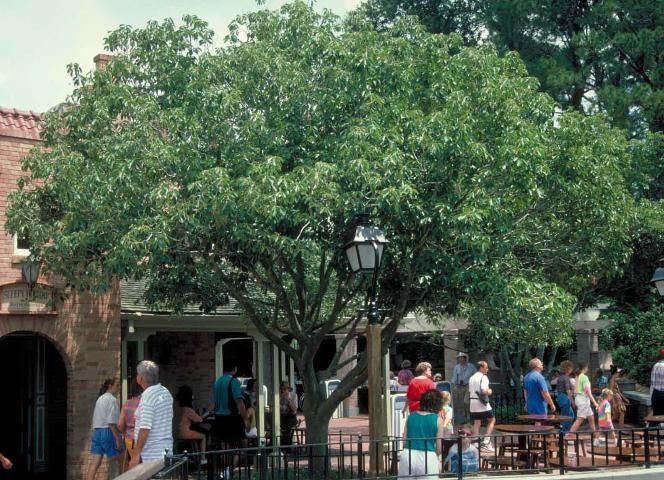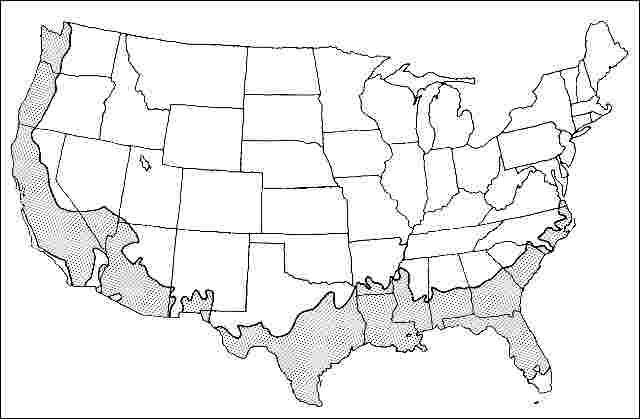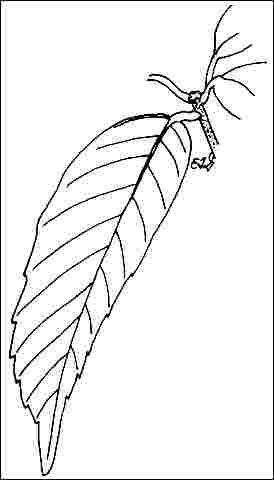Quercus glauca: Blue Japanese Oak1
Introduction
At first glance, this plant would hardly be thought to be an oak. Creating a very formal, dense, round or oval shade, evergreen blue Japanese oak grows slowly to 25 to 40 feet in height with a spread of 25 to 35 feet. The new growth is often bronze- or purple-tinted, and develops into shiny, dark green, 2.5- to 5.5-inch-long by 1- to 2.5-inch-wide, leathery leaves. It is a very attractive tree suited for many uses.

Credit: Ed Gilman, UF/IFAS
General Information
Scientific name: Quercus glauca
Pronunciation: KWERK-us GLAW-kuh
Common name(s): Blue Japanese oak, ring-cupped oak
Family: Fagaceae
USDA hardiness zones: 8A through 9B (Fig. 2)
Origin: not native to North America
Invasive potential: little invasive potential
Uses: street without sidewalk; parking lot island 100-200 sq ft; shade; parking lot island > 200 sq ft; tree lawn 3-4 feet wide; tree lawn 4-6 feet wide; tree lawn > 6 ft wide; highway median
Availability: not native to North America

Description
Height: 25 to 40 feet
Spread: 25 to 35 feet
Crown uniformity: symmetrical
Crown shape: round, oval
Crown density: dense
Growth rate: slow
Texture: medium
Foliage
Leaf arrangement: alternate (Fig. 3)
Leaf type: simple
Leaf margin: serrate, dentate
Leaf shape: oblong, obovate, elliptic (oval)
Leaf venation: pinnate
Leaf type and persistence: broadleaf evergreen, evergreen
Leaf blade length: 2 to 4 inches, 4 to 8 inches
Leaf color: green
Fall color: no color change
Fall characteristic: not showy

Flower
Flower color: brown
Flower characteristics: not showy
Fruit
Fruit shape: oval, round
Fruit length: .5 to 1 inch
Fruit covering: dry or hard
Fruit color: brown
Fruit characteristics: does not attract wildlife; not showy; fruit/leaves a litter problem
Trunk and Branches
Trunk/bark/branches: branches droop; not showy; typically one trunk; thorns
Pruning requirement: needed for strong structure
Breakage: susceptible to breakage
Current year twig color: green, brown
Current year twig thickness: thick
Wood specific gravity: unknown
Culture
Light requirement: full sun
Soil tolerances: clay; sand; loam; acidic; occasionally wet; well-drained
Drought tolerance: high
Aerosol salt tolerance: unknown
Other
Roots: not a problem
Winter interest: no
Outstanding tree: no
Ozone sensitivity: unknown
Verticillium wilt susceptibility: resistant
Pest resistance: resistant to pests/diseases
Use and Management
Blue Japanese oak has been used as a street and parking lot tree in parts of the southeast for a number of years. Was used in USDA hardiness zone 7b until the 1983 freeze which reduced large trees to a collection of sprouts. It appears to be tolerant of drought and poor, clay soil including those which are poorly-drained and grows well in tight soil spaces. Its tight crown lends a formal feel to the landscape.
Many upright trunks and branches originate from one point on the trunk without initial training, and this structure could lead to a weak tree. Following initial training and pruning to develop a central leader and well-spaced branches, little care should be needed to maintain this tree. It should be grown and planted more in urban areas in the South.
Blue Japanese oak should be grown in full sun. It is tolerant of a wide range of soils, including heavy clay soils.
Propagation is by seed.
Pests and Diseases
There is a large number of potential problems on oaks, but none of major concern.


